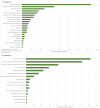Maternal characteristics associated with referral to obstetrician-led care in low-risk pregnant women in the Netherlands: A retrospective cohort study
- PMID: 36921011
- PMCID: PMC10016726
- DOI: 10.1371/journal.pone.0282883
Maternal characteristics associated with referral to obstetrician-led care in low-risk pregnant women in the Netherlands: A retrospective cohort study
Abstract
Background: In the Netherlands, maternity care is divided into midwife-led care (for low-risk women) and obstetrician-led care (for high-risk women). Referrals from midwife-led to obstetrician-led care have increased over the past decade. The majority of women are referred during their pregnancy or labour. Referrals are based on a continuous risk assessment of the health and characteristics of mother and child, yet referral for non-medical factors and characteristics remain unclear. This study investigated which maternal characteristics are associated with women's referral from midwife-led to obstetrician-led care.
Materials and methods: A retrospective cohort study in one midwife-led care practice in the Netherlands included 1096 low-risk women during January 2015-17. The primary outcomes were referral from midwife-led to obstetrician-led care in (1) the antepartum period and (2) the intrapartum period. In total, 11 maternal characteristics were identified. Logistic regression models of referral in each period were fitted and stratified by parity.
Results: In the antepartum period, referral among nulliparous women was associated with an older maternal age (aOR, 1.07; 95%CI, 1.05-1.09), being underweight (0.45; 0.31-0.64), overweight (2.29; 1.91-2.74), or obese (2.65; 2.06-3.42), a preconception period >1 year (1.34; 1.07-1.66), medium education level (0.76; 0.58-1.00), deprivation (1.87; 1.54-2.26), and sexual abuse (1.44; 1.14-1.82). Among multiparous women, a referral was associated with being underweight (0.40; 0.26-0.60), obese (1.61; 1.30-1.98), a preconception period >1 year (1.71; 1.27-2.28), employment (1.38; 1.19-1.61), deprivation (1.23; 1.03-1.46), highest education level (0.63; 0.51-0.80), psychological problems (1.24; 1.06-1.44), and one or multiple consultations with an obstetrician (0.68; 0.58-0.80 and 0.64; 0.54-0.76, respectively). In the intrapartum period, referral among nulliparous women was associated with an older maternal age (1.02; 1.00-1.05), being underweight (1.67; 1.15-2.42), a preconception period >1 year (0.42; 0.31-0.57), medium or high level of education (2.09; 1.49-2.91 or 1.56; 1.10-2.22, respectively), sexual abuse (0.46; 0.33-0.63), and multiple consultations with an obstetrician (1.49; 1.15-1.94). Among multiparous women, referral was associated with an older maternal age (1.02; 1.00-1.04), being overweight (0.65; 0.51-0.83), a preconception period >1 year (0.33; 0.17-0.65), non-Dutch ethnicity (1.98; 1.61-2.45), smoking (0.75; 0.57-0.97), sexual abuse (1.49; 1.09-2.02), and one or multiple consultations with an obstetrician (1.34; 1.06-1.70 and 2.09; 1.63-2.69, respectively).
Conclusions: This exploratory study showed that several non-medical maternal characteristics of low-risk pregnant women are associated with referral from midwife-led to obstetrician-led care, and how these differ by parity and partum period.
Copyright: © 2023 Niessink-Beckers et al. This is an open access article distributed under the terms of the Creative Commons Attribution License, which permits unrestricted use, distribution, and reproduction in any medium, provided the original author and source are credited.
Conflict of interest statement
The authors have declared that no competing interests exist.
Figures
References
-
- Royal College of Obstetricians and Gynaecologists. The National Sentinel Caesarean Section Audit Report. London: RCOG Clinical Effectiveness Support Unit, 2001. [ISBN 1–900364–66–2.].
-
- Perined. Perinatal Care in the Netherlands 2002–2021. In Dutch, available from: https://www.perined.nl/onderwerpen/publicaties-perined/jaarboek-zorg Accessed februari 2018.
-
- Offerhaus PM. Patterns in primary midwife-led care in the Netherlands. Trends and variation in intrapartum referrals. Radboud University Nijmegen. 2015:9–10.
MeSH terms
LinkOut - more resources
Full Text Sources
Miscellaneous


